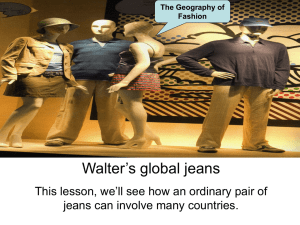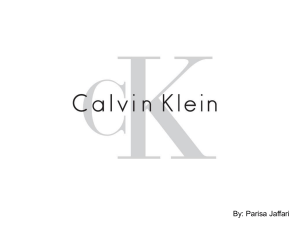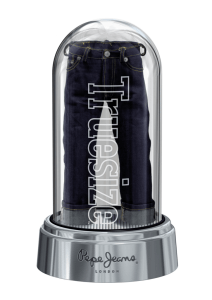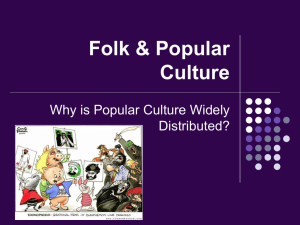In Switzerland, even jeans are neutral!
advertisement
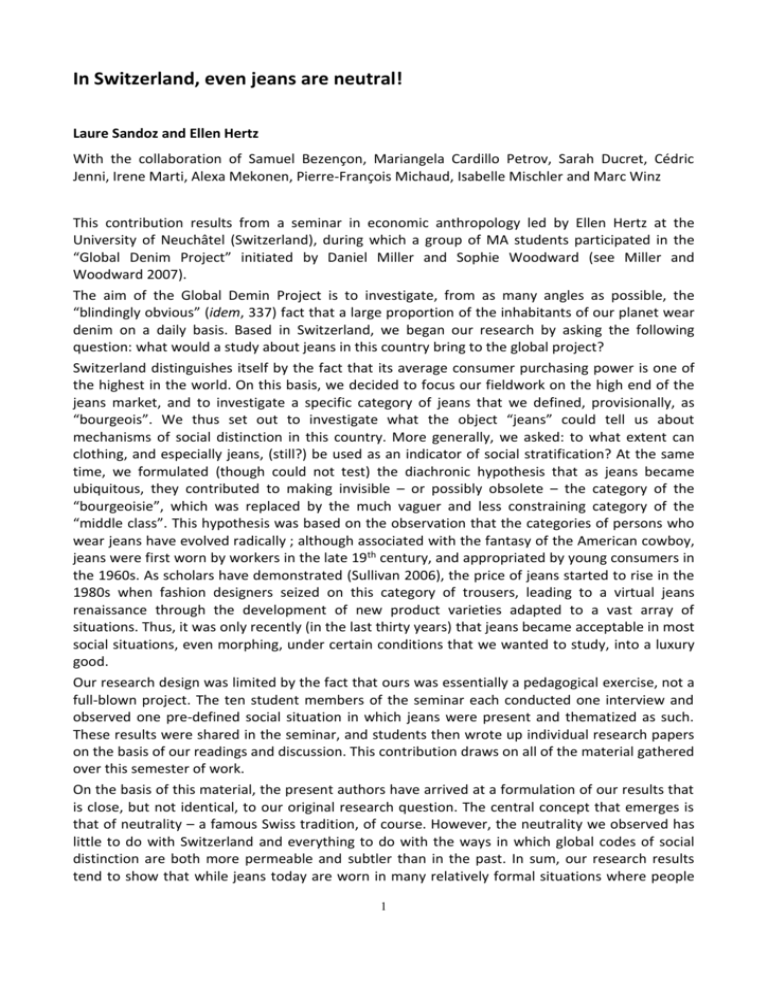
In Switzerland, even jeans are neutral! Laure Sandoz and Ellen Hertz With the collaboration of Samuel Bezençon, Mariangela Cardillo Petrov, Sarah Ducret, Cédric Jenni, Irene Marti, Alexa Mekonen, Pierre-François Michaud, Isabelle Mischler and Marc Winz This contribution results from a seminar in economic anthropology led by Ellen Hertz at the University of Neuchâtel (Switzerland), during which a group of MA students participated in the “Global Denim Project” initiated by Daniel Miller and Sophie Woodward (see Miller and Woodward 2007). The aim of the Global Demin Project is to investigate, from as many angles as possible, the “blindingly obvious” (idem, 337) fact that a large proportion of the inhabitants of our planet wear denim on a daily basis. Based in Switzerland, we began our research by asking the following question: what would a study about jeans in this country bring to the global project? Switzerland distinguishes itself by the fact that its average consumer purchasing power is one of the highest in the world. On this basis, we decided to focus our fieldwork on the high end of the jeans market, and to investigate a specific category of jeans that we defined, provisionally, as “bourgeois”. We thus set out to investigate what the object “jeans” could tell us about mechanisms of social distinction in this country. More generally, we asked: to what extent can clothing, and especially jeans, (still?) be used as an indicator of social stratification? At the same time, we formulated (though could not test) the diachronic hypothesis that as jeans became ubiquitous, they contributed to making invisible – or possibly obsolete – the category of the “bourgeoisie”, which was replaced by the much vaguer and less constraining category of the “middle class”. This hypothesis was based on the observation that the categories of persons who wear jeans have evolved radically ; although associated with the fantasy of the American cowboy, jeans were first worn by workers in the late 19th century, and appropriated by young consumers in the 1960s. As scholars have demonstrated (Sullivan 2006), the price of jeans started to rise in the 1980s when fashion designers seized on this category of trousers, leading to a virtual jeans renaissance through the development of new product varieties adapted to a vast array of situations. Thus, it was only recently (in the last thirty years) that jeans became acceptable in most social situations, even morphing, under certain conditions that we wanted to study, into a luxury good. Our research design was limited by the fact that ours was essentially a pedagogical exercise, not a full-blown project. The ten student members of the seminar each conducted one interview and observed one pre-defined social situation in which jeans were present and thematized as such. These results were shared in the seminar, and students then wrote up individual research papers on the basis of our readings and discussion. This contribution draws on all of the material gathered over this semester of work. On the basis of this material, the present authors have arrived at a formulation of our results that is close, but not identical, to our original research question. The central concept that emerges is that of neutrality – a famous Swiss tradition, of course. However, the neutrality we observed has little to do with Switzerland and everything to do with the ways in which global codes of social distinction are both more permeable and subtler than in the past. In sum, our research results tend to show that while jeans today are worn in many relatively formal situations where people 1 want to look chic or elegant, the fact that they can adapt to these situations depends not so much on jeans' intrinsic qualities as on the way they are worn in association with other clothes and accessories, creating a general “look” that is appropriate to the context. To illustrate this idea, one of our interviewees compared jeans with bread, because bread can accompany both an ordinary meal – if spread with peanut butter and jelly, for example – and a gastronomic delicacy – if served with foie gras or caviar. In this sense, jeans in themselves are regarded a “staple”, as highly neutral clothing for which a process of customization is necessary in order to signify specific styles or social groups. Yet our data also suggest that certain categories of jeans are better adapted to these kinds of transformation than others. We conducted our fieldwork in different French and German-speaking cities in Switzerland. We interviewed vendors and consumers about which jeans were “chic” or “elegant” and what they meant to them; we observed how jeans where bought and sold; we did a small inquiry over the Internet to check the way high-end jeans were advertised; and we investigated some of the places or situations where wearing jeans was frowned on or outright prohibited. To complete this work, one student produced a short documentary film on jeans, which we will use to illustrate the different sections of this article. Before going on, we would like to make a final remark on the “Swissness” of our study. The risk with studying the same phenomena around the globe is that one fall into “methodological nationalism” (Wimmer & Glick Schiller, 2002), categorizing each “case study” according to its country of origin. In our case, we do not think that the scope of our results should be limited to Switzerland. In the same line, our conclusions probably do not apply to the whole of the Swiss population. Our study focuses on the way people invest jeans with meaning in order to distinguish themselves from others in an urban context where average purchasing power is significantly higher than in the suburbs or more rural areas. Accordingly, this work has probably less to tell us about Switzerland than about the way consumer goods contribute to give meaning to people's lives in urban, cosmopolitan, consumer settings. A multifunctional garment http://youtu.be/4gvo-5w-_CQ [click to see the first part of the film] In case our readers were not yet convinced, the first part of this film clearly shows that jeans have become a predominant garment in our wardrobes. Ilaria owns seven pairs of jeans that she wears every day and in almost every situation. Yet each pair possesses certain characteristics that make it special for her. Our fieldwork clearly shows that her attitude towards jeans is anything but unique. To go further, let us look at some of the modes of categorization that were generally applied to jeans in our interviews. As mentioned in the introduction, we focused our study on high-end jeans that could potentially be used to mark one's distinction from others. To probe this question, we imagined situations where one might want to look one’s best – for example at a job interview, the opera or a fancy gathering – and asked people if wearing jeans would be appropriate in such situations. Since the terms “bourgeois” or “upper-class” are not usually employed in everyday life, we used the adjectives “chic” or “elegant” to describe the kind of jeans we were looking for. Given that the French word “chic” is defined as that “which is elegant and distinguished” (Larousse 2012, our translation) while the French word “élégant” “refers to clothing that reveals the taste of the person who wears it and that gives this person an air of distinction” (ibid), we felt that these two 2 adjectives properly targeted the concept we wanted to probe with the notion of “bourgeois”, that is: social distinction. Responses to this question suggest that while jeans tend to be banned in some formal contexts – especially at work – the norm governing the wearing of jeans turns more around color than around material: in places where jeans are not desired, the pants designated as “jeans” are usually blue jeans and not denim in general. For example, a vendor in a jeans shop told us that it would be no problem to wear a pair of slim black jeans for a job interview but that she would avoid blue jeans, especially if faded. Similarly, another interview suggests that while many employees associated their company's weekly “casual Friday” with the pleasure of wearing jeans – which they would not do during the rest of the week – they preferred dark or colored denim to traditional blue jeans that might seem too casual to wear to work. For women, we noticed that slim dark jeans, decorated with embroidery or small brilliant objects, tend to be viewed as especially “chic”. Our fieldwork thus allows us to establish a first distinction between two general categories of jeans: on the one hand, blue-jeans, faded, damaged or wide, which are not appropriate in formal situations, and on the other, denim, which means here jeans that are either darker blue or another color, sometimes decorated, and generally new and rather slim. Yet even if jeans from this last category can be worn in situations in which one strives to be “chic”, several interviewees suggested that these pants are not chic, formal or elegant in and of themselves. Rather, a person's general appearance depends on the other cloths and accessories he or she wears in addition. This goes along with the observation that one of the main reasons why jeans are so appreciated and worn is their multi-functionality. We can therefore conclude that jeans do not adapt to formal situations because of their formality but because they are regarded as both neutral and polysemic, accompanying the person's general look as appropriate to the context. It is, furthermore, interesting to notice that the category of jeans that can become “chic” or “elegant” is not necessarily expensive. Conversely, some distressed and eccentric jeans – not appropriate in formal contexts – can cost a lot of money, especially if they are branded or produced by a designer. In the same line, women's jeans tend to be cheaper than men's jeans even if the former were more often identified as appropriate to formal occasions. Our interviews revealed several distinctions between the categories “chic”, “elegant”, “classical”, “formal” and “casual”, which give a first hint as to how to understand these price differences. For some of our interviewees, jeans can be chic but not elegant. Others differentiated between formal situations, where they would rather not wear jeans because it would be “culturally inappropriate”, and situations like a party with friends or a special event, where a nice pair of jeans would make a person look sexy and chic. One of the interviewees differentiated between two styles that she considered as chic in very different ways and that illustrate the ambiguity of this word: on the one hand, she identified what she called a “trendy” style, preferred by young people, “a neat look” with a “search for style”, not really chic but “a form of chic”; on the other hand, she spoke of a “preppy” style found mainly on older people, more polished and preferably without jeans1. Similarly, we observed that jeans, while invisible in most situations because of their ubiquity, can become a sign of distinction when worn in contexts where they are rarer. Some advertising posters also use this contrast when showing a man wearing very formal clothing and jeans, which produces a general impression of elegance and freedom. The use of the same adjective to describe very different styles related to different categories of people reveals the relativity and context-dependence of this particular article of clothing. At the same time, it suggests the elaboration of new strategies of distinction, by which jeans can either 1 In French, the interviewee used the terms « chic-jeune-branché » and « chic-vieux-BCBG ». 3 cohabit with or confront older strategies. This is the case, for example, when a man in a formal situation combines a dress shirt and a tie with a slim pair of jeans in order to create a slightly provoking but nevertheless elegant look, or when a young person who wants to look chic wears very expensive branded clothing, among which fashion jeans, that totally differ from the “traditional” suit, dress, or smoking jacket. Finally, it shows the complexity of jeans: jeans are clothing whose meaning does not depend on the garment alone, since the same pair of jeans can create a very different impression depending on the context in which it is worn, on the person who wears it and on the cloths and accessories that accompany it. These conclusions may seem obvious for a social scientist used to taking into account the contextdependence of social practices in general. But if we compare jeans with other kinds of clothing, for example a pair of silk trousers for a woman or a tweed jacket for a men, we notice that these garments are much less prone than jeans to adapt to a large variety of contexts or to participate in the creation of different styles, no matter how they are accessorized. In this sense, while multifunctionality is a characteristic that applies to all clothing to various degrees, it is central and omnipresent in the case of jeans. We will come back to the related idea of jeans' neutrality in the last chapter. For now, let us further develop the question of price in relation to the notion of quality. More specifically, we would like to analyze how meaning can generate money in the context of salesperson-consumer relationships. A trouser-full of meaning http://youtu.be/SBPa5uiUbZk [click to see the second part of the film] Dians, the man in the movie, considers himself to be an artist. The objects he makes from jeans are like his “paintings”, through which he expresses what he has on his mind. If he wants clients to buy his products for a good price, he also has to convince them of their originality and of the artistic capital they will gain by wearing them. His discourse can therefore be regarded as an attempt to give value (both monetary and cultural) to his creations by filling them with meaning. Callon et al.’s approach to the qualification and evaluation of commodities (2000) seems particularly relevant for understanding the process by which a garment can be given meaning in order to increase its value. The authors argue that the value of commodities is the result of a dynamic process of qualification, during which various actors (retailers, manufacturers, consumers, advertisers...) select specific characteristics of a product and compete to have them recognized as valuable2. In this sense, the “quality” of a product depends on the criteria by which one chooses to evaluate it. Originality or aesthetic value may be an option, but one can also focus on practicality or robustness. In the clip, Dians encourages us to take into account the artistic work behind the product in order to legitimize the high value of what he sells. Our own attempts to identify high-end jeans led us to observe similar mechanisms at work in the way “quality” is constructed in order to justify higher prices. For example, one of us went to a shop specialized in jeans that sold brands like Levi's, Lee and Wrangler, and whose prices were between 100 and 250 CHF. When she asked what “good quality jeans” were, the vendor answered that 2 See also Jeannerat : « [the market value of a good or a service] results from a dynamic social process of valuation whereby particular actors (e.g. producers, consumers or intermediaries) coordinate and mobilize resources to assign a particular socio-economic value to different market objects (e.g. goods or services) » (2012 : 3) 4 quality implied sturdiness. She added that the shape was also important because jeans should adapt to a person's morphology. Our colleague then went to another shop specialized in luxury clothing with brand-name jeans like Armani or Burberry and prices between 250 and 500 CHF. This time, the salesperson explained that the jeans were of good quality because they were faded or decorated by hand. When the student asked her if she would be able to tell the difference between a person wearing jeans of this kind and a person wearing a cheaper pair of jeans, the salesperson answered “maybe”, because she worked with those brands and knew them well, but she did not seem completely sure. We see here the variability of the term “quality”, which highlights the fact that when different people legitimate a purchase by saying that it is of good quality, they may in fact be referring to very different things. In a similar vein, two other students made an interesting observation concerning what an interviewed salesperson called the “inner life of jeans3”. This referred to small details, invisible to the uninformed, that signaled a special effort in the process of production. It could be, for example, a small pocket sewn inside the jeans or the addition of handmade stitching that would participate in the production of “secret knowledge” about the jeans, thereby attesting to the brand's quality – as well as justify a higher price. The care taken in the creation of invisible details and the fact that people agree to spend more because of these details surprised us a great deal. What is more, we have already mentioned that a pair of jeans does not create a look alone: even if most of the interviewees agreed with the fact that jeans must enhance the shape of one’s body, they added that the overall style is given by accessories and other clothes worn with the jeans. So why buy a 400 CHF pair of jeans when you can find one that is virtually identical for less than 100 CHF? Because it will last longer? Because it has a nicer shape? These two answers seem logical and coherent. But because of its “inner life”?!? Our hypotheses for explaining why some people buy expensive jeans whose difference is almost invisible is related to the observation made by Miller and Woodward (2007) in their Manifesto for the Study of Denim. They highlight the ability of jeans to relieve the anxiety of having to choose what to wear; jeans represent a “safe” piece of clothing – because of their ubiquity – while remaining an item full of possibilities, allowing one to give free rein to one's creativity and to transform oneself accordingly. In this sense, to buy expensive jeans with a “secret life” may be a way for people to reassure themselves of their own quality and particularity, a way to distinguish themselves not so much in the eyes of other but in their own eyes. At the same time, these coded features often work as a sign of distinction in very select circles, whose members have been initiated into recognizing and appreciating these particular items of luxury clothing. Yet we should be careful not to limit the symbolic meaning given to jeans to commercial influences. Our research – as well as many of the contributions to the Global Denim Project's website – shows that a favorite pair of jeans can become very important for a person, for example by reminding him or her of a specific moment or by creating a sense of continuity between different periods of his or her life. What is interesting in all these instances is how a simple pair of jeans can influence the way a person feels in the here and now. Jeans as “subjectivisors” http://youtu.be/fGIv4ypWKOo [click to see the third part of the film] For Ruedi, jeans are a passion. He has collected thousands of them and associates each pair with a 3 In French : « la vie intérieure des jeans » 5 story. While the various pants that Ruedi shows us in the movie do not seem very different from one another, their origin, their function and the way they have been worn can differ greatly from pair to pair. The ability of jeans to convey meaning, as well as their complex history (from workers’ clothing to luxury goods) help us understand how jeans could become so important for a man that he collects thousands of them and creates what is in essence a private museum. However, we still do not know why jeans are so ubiquitous. Our study leads us to think that the cornerstone of the explanation lies in the relationship between neutrality and meaning, which allows a simple pair of jeans to become significant. When trying to explain how a jeans can become an object of distinction, a student of our group proposed three verbs to describe the process through which an originally neutral pair of jeans is given personality: to combine, to know and to feel. First, as outlined above, jeans do not reflect a style in and of themselves. To make them look chic – or casual, or scruffy, or any other style – you need to combine them with other clothes and accessories. To do so, you need to know the cultural codes related to a certain context, since distinction is a subtle mixture between conformism and originality, between being noticed and blending in. Finally, one’s general appearance also depends on the way one feels about one’s body and the shapes, textures or colors that suit it. According to our interviewees, a good pair of jeans has to adapt to and enhance the morphology of one's body. A perfect pair of jeans should therefore be like a second skin, providing comfort and well-being. Yet this criterion too appears subject to multiple interpretations: our interviewees disagreed about whether jeans were more comfortable when slim or baggy, and while some appreciated stretch fabric, others found it completely uncomfortable. This reminds us that the perceptions we have of our body are also the results of incorporated social constructions. The result of this process is that jeans, because of their perceived neutrality, can become almost anything while at the same time absorbing an extremely personalized assemblage of symbols and affect. But what does it mean to say that jeans are “neutral”? From a constructivist point of view, we should not assume that neutrality is the result of the object's intrinsic qualities, but rather ask how this neutrality is constructed. This brings us back to our first hypothesis on the invisibilisation of the bourgeoisie in Switzerland. In La culture des individus (2004), sociologist Bernard Lahire critiques Bourdieu's famous book La distinction. Critique sociale du jugement (1979), arguing that the separation between social strata in contemporary society is much less rigid than it was forty years ago. He shows that individuals navigate between different social contexts in their daily life and thereby develop tastes that are not necessarily consonant with their social background. He also rejects Bourdieu's assumption that the main strategy used by poorer people in order to gain higher social status is to accept and imitate the cultural codes of the rich: the situation is much more complex and a vast array of codes of distinction exists within each social stratum. One can think, for example, of the many different styles displayed by teenagers. In the same line, let us not forget that in many situations, being too well dressed is not appropriate since it can give the impression that one is snobbish, boring or stiff. Furthermore, it seems that people tend to distinguish themselves first from persons close to them. The great challenge is then to look unique without becoming an outsider. In this sense, the codes of the upper class are not necessarily the most appealing or useful. Our observations concerning changes in the way “chicness” and “elegance” are produced today should help us tease out a series of competing hypotheses. As already mentioned, places where jeans are absent have become very rare, as jeans have increasingly “adapted” to formal situations. This reflects the much studied fact that the very concept of a “bourgeois” social sphere is no longer apposite in studies of social stratification. Even Marxist-oriented analyses adopt a more subtle and multi-dimensional view of the relation between social strata, and innumerable studies 6 have shown that the vast majority of the populations of industrialized Western societies identify themselves as “middle class” on the basis of criteria such as universal high-school level education, salaried work and access to consumer goods. A more contemporary term of analysis – that allows for parallels with other development in contemporary urban life – would be the concept of “gentrification”. The “gentrification of jeans” would thus describe the process through which a kind of clothing principally worn by workers was reappropriated by the middle and upper classes to the point that it became, in some cases, a luxury item4. Returning to our original hypothesis, we could argue one of two things: either that jeans have been an instrument for the recoding and invisibilisation of class difference, or that their ubiquity is a sign of the emergence of new values and social codes that downplay the importance of social class.5 In either case, jeans emerge as the item of clothing that, par excellence, signals the final demise of sumptuary laws or norms, that is, the explicit social regulation of dress as a function of class status. We could also propose a more functional explanation for this evolution. Jeans are perhaps the ideal bodily vessel for navigating between different social worlds, whether at work or with friends, with one’s spouse or one’s parents, with one’s sports team or out to dinner in a restaurant. The construction of jeans as “neutral” can therefore be related to the multiplicity of social situations that individuals must negotiate in their everyday life, and to the need to facilitate the transitions between these situations. This hypothesis is close to the thesis developed by Miller and Woodward in their book Blue Jeans: the Art of the Ordinary (2012). According to them, jeans allow individuals to inhabit what they call “the ordinary” precisely because they do not express cultural or social difference. The fact that jeans became regarded as socially and culturally “unmarked” – what we are calling neutral or multi-functional – helps to explain how such a piece of clothing can relieve the anxiety of having to choose what to wear, the other thesis developed by Miller and Woodward in their Manifesto for the Study of Denim (2007). Finally, we must not forget the main teaching of our study: that jeans cannot be understood or interpreted alone but must be analyzed in relation to the other items of clothing, jewelry or “lifestyle” with which a given wearer associates them. Jeans are, in this sense, assemblages that shift attention from away from objects as such and onto the taste, skill, style and personality of their occupants. Thus, the ubiquity of jeans and the construction of their neutrality, while contributing to soften the dress-code's rigor in many contexts, also give rise to subtler forms of distinction, distinction focused not on what one can own but on what one can be, feel and express. We consider this analysis complementary to that of Miller and Woodward (2012) who focused on the way “people are trying to become less marked and struggling to be regarded as entirely ordinary” (p. 8). The fact that jeans, as both the two authors and our research team noticed, “are a kind of canvas that can be painted on to produce creative styles” (p. 91) gives space for originality as much as for conformism, for distinction as much as for assimilation. It is in this sense that we 4 This phrase appears in a fashion commentator’s blog about the presence of denim (notably shirts for men) in the runway shows of designers in the fall of 2012 (see http://www.fashionbeans.com/2012/aw12-fashion-trend-thegentrification-of-denim/, last consulted April 20, 2014). Interestingly, the author seems to have doubts about the ability of denim to shed its working-class associations; our data suggests that these doubts are misplaced, even coquettish. 5 Another author encountered on-line refers to the “gentrification” of jeans. She argues that denim has “crossed over class, gender, age, regional, national and ideological lines”, and that this is the reason “behind its ecumenical appeal”. She too, however, points to the difficulty in pinning down jeans’ social function. “No other garment has served as such an example of status ambivalence and ambiguity than blue jeans” (see http://www.history.utoronto.ca/material_culture/cynth/, last consulted on April 21, 2014). 7 speak of jeans as “subjectivisors”, as objects that activate processes of self-positioning, selfdetermination and self-expression, even if this self-expression takes the form of neutrality or nonremarkableness. In this sense, the notion that jeans are “a second skin”, a sentiment we heard from a number of our interviewees, seems right on target. Conclusion: everybody can talk about jeans http://youtu.be/JvHJQ36aW0A [click to see the final part of the film] Clearly, suggesting that contemporary consumer societies are experiencing greater permeability between social strata or pointing to the invisibilisation of class distinctions through apparel is not the same thing as saying that social stratification is a thing of the past. We cannot deny the persistence of social inequality and its reproduction over generations, and it is glaringly obvious that certain institutions are much more accessible to the upper classes than to the rest of the world. In Switzerland, while many consumers are able to spend 500 Swiss francs for a pair of jeans if they really want to, other kinds of activities or properties are available only to the richest, for example home-ownership or expensive vacations. Spending on this scale plays a central role in differentiating between social strata, while clothing plays on more multiform graduations that signal interiorized notions of taste, style and self-image. This being said, we still need to explain the iconic status of jeans as the great democratizer. We should start by noticing that jeans’ capacity to challenge class classifications is in no way a recent phenomenon. In his famous ode to U.S. counter-culture, Charles Reich announced in 1970 already that jeans “express profoundly democratic values. There are no distinctions of wealth or status, no elitism; people confront one another shorn of these distinctions” (Reich 1971, quoted in Davis 1989: 347). This should be the first clue that we anthropologists (or sociologists, or academic social scientists in general) have no monopoly on the “interpretation of jeans”, to highjack a Freudian expression. To the contrary, it seems that with the democratization of jeans has come a democratization of discourse about jeans. Already in 1993, the New York Times was calling this phenomenon “speaking in jeans”6. Is it possible that through their very neutrality, jeans compel us to talk about them, to wonder what they mean, to make sense of them? Are jeans making anthropologists out of all of us? BIBLIOGRAHPHY BOURDIEU Pierre. 1979. La distinction. Critique sociale du jugement. Paris: Editions de minuit. CALLON Michel, MEADEL Cécile & RABEHARISOA Vololona. 2000. « L'économie des qualités », Politix 13(52): 211-239. JEANNERAT Hugues. 2012. “Staging experience, valuing authenticity: Towards a market perspective on territorial development”, European Urban and Regional Studies 20(4): 370-385. DAVIS Fred. 1989. “‘Of Maids’ Uniforms and Blue Jeans: The Drama of Status Ambivalences in 6 See http://www.nytimes.com/1993/01/10/style/speaking-in-jeans.html (last consulted April 21, 2014). 8 Clothing and Fashion”, Qualitative Sociology 12(4): 337-355. LAHIRE Bernard. 2004. La Culture des individus. Dissonances culturelles et distinction de soi. Paris : La Découverte. LAROUSSE, Dictionnaires français [online]. http://www.larousse.fr/dictionnaires/francais/chic and http://www.larousse.fr/dictionnaires/francais/élégant, [last consulted on January 9, 2014]. MILLER Daniel & WOODWARDS Sophie. 2012. Blue Jeans: the Art of the Ordinary. Berkeley, Los Angeles: University of California Press. MILLER Daniel & WOODWARDS Sophie. 2007. “Manifesto for a study of denim”, Social Anthropology 15(3): 335-351. REICH Charles A. 1971. The Greening of America. New York: Bantam Books. SULLIVAN James. 2006. Jeans: A Cultural History of an American Icon. New York: Gotham Press. WIMMER Andreas & GLICK SCHILLER Nina. 2002. “Methodological nationalism and beyond: nation-state building, migration and the social sciences”, Global Networks 2(4): 301-334. 9

